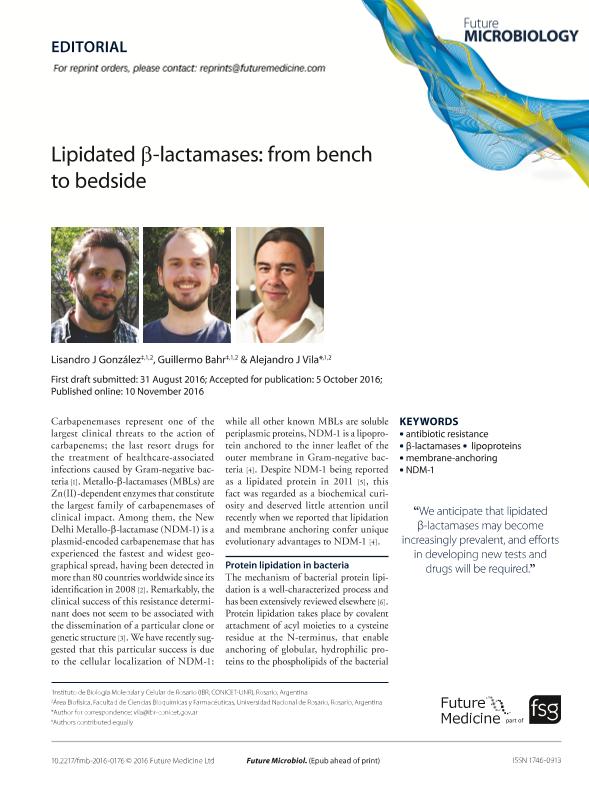Artículo
Lipidated β-lactamases: from bench to bedside
Fecha de publicación:
12/2016
Editorial:
Future Medicine
Revista:
Future Microbiology
ISSN:
1746-0913
Idioma:
Inglés
Tipo de recurso:
Artículo publicado
Clasificación temática:
Resumen
Carbapenemases represent one of the largest clinical threats to the action of carbapenems; the last resort drugs for the treatment of healthcare-associated infections caused by Gram-negative bacteria [1]. Metallo-β-lactamases (MBLs) are Zn(II)-dependent enzymes that constitute the largest family of carbapenemases of clinical impact. Among them, the New Delhi Metallo-β-lactamase (NDM-1) is a plasmid-encoded carbapenemase that has experienced the fastest and widest geographical spread, having been detected in more than 80 countries worldwide since its identification in 2008 [2]. Remarkably, the clinical success of this resistance determinant does not seem to be associated with the dissemination of a particular clone or genetic structure [3]. We have recently suggested that this particular success is due to the cellular localization of NDM-1: while all other known MBLs are soluble periplasmic proteins, NDM-1 is a lipoprotein anchored to the inner leaflet of the outer membrane in Gram-negative bacteria [4]. Despite NDM-1 being reported as a lipidated protein in 2011 [5], this fact was regarded as a biochemical curiosity and deserved little attention until recently when we reported that lipidation and membrane anchoring confer unique evolutionary advantages to NDM-1 [4].
Palabras clave:
Antibiotic Resistance
,
Lipoproteins
,
Membrane-Anchoring
,
Ndm-1
,
Β-Lactamases
Archivos asociados
Licencia
Identificadores
Colecciones
Articulos(IBR)
Articulos de INST.DE BIOLOGIA MOLECULAR Y CELULAR DE ROSARIO
Articulos de INST.DE BIOLOGIA MOLECULAR Y CELULAR DE ROSARIO
Citación
Gonzalez, Lisandro Javier; Bahr, Guillermo; Vila, Alejandro Jose; Lipidated β-lactamases: from bench to bedside; Future Medicine; Future Microbiology; 11; 12; 12-2016; 1495-1498
Compartir
Altmétricas




